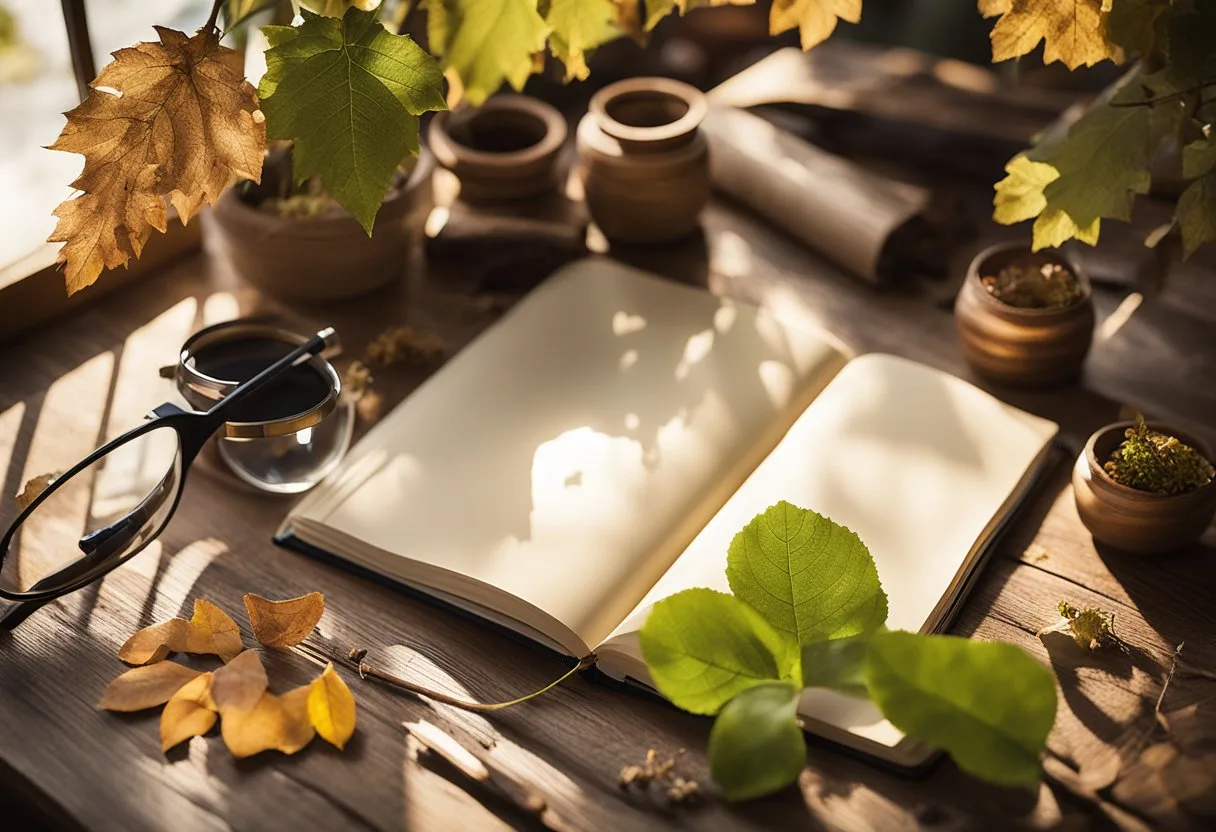Nature journaling is a fun and engaging practice that helps connect individuals with the natural world. It involves recording observations about birds, plants, trees, and other natural things on paper. Nature journaling is a simple and effective tool that can help individuals improve their observation skills and see big picture ecological patterns more clearly. In this blog post, I will show you how to nature journal and provide you with tips and prompts to help you get started.
Keeping a nature journal can help individuals appreciate the beauty and complexity of the natural world. It can also help them develop a deeper curiosity and understanding of the environment around them. Nature journaling can be a great way to document personal growth and change over time, as well as to track the progress of a particular ecosystem or habitat.
To get started with nature journaling, all that is needed is a journal and a pen or pencil. There are no rules or guidelines to follow, and individuals are free to record whatever they find interesting or inspiring. Whether it is a sketch of a bird, a description of a flower, or a list of observations about a particular habitat, nature journaling can be a rewarding and fulfilling practice for anyone who loves the outdoors.
How to nature journal
Here is how to start a nature journal:
- Gather your materials, including a journal or sketchbook, pencils or pens, and possibly watercolors or colored pencils.
- Choose a natural setting, such as a park, garden, forest, or even your own backyard.
- Find a comfortable spot to sit or stand where you can observe your surroundings without causing disturbance.
- Start by noting the date, time, weather conditions, and location at the top of your journal page.
- Take a moment to observe your surroundings using all your senses. What do you see, hear, smell, and feel?
- Choose a specific subject or scene to focus on, such as a plant, animal, landscape, or natural phenomenon.
- Begin sketching your subject, focusing on the shapes, patterns, and details. Don’t worry about creating a perfect drawing; the goal is to capture your observations.
- Write down any notes about your subject, such as colors that are hard to replicate, behaviors observed, or the subject’s environment.
- If you’re interested in the scientific aspect, you can include additional data such as measurements, counts, or species identification.
- Reflect on your experience and write down any thoughts, feelings, or questions that arise while you’re observing and journaling.
- If you have more time, repeat the process with different subjects or from different perspectives to add variety to your journal.
- Regularly review your journal entries to notice patterns, changes, or growth in your skills and observations over time.
Nature journal prompts
- Sketch the outline of a single leaf, noting its shape and veins.
- Write a short description of the weather each day for a week.
- Draw a flower from your garden or a local park, focusing on its structure.
- Observe and note the behavior of birds at a feeder or in the trees.
- Collect a few different rocks and describe their textures and colors.
- Listen to the sounds of nature and write down what you hear in words or symbols.
- Photograph a tree and then try to draw it, capturing its form and texture.
- Record the phases of the moon you observe each night for a month.
- Paint a sunset using watercolors, and describe the colors you see.
- Document the different types of insects you find on a walk, noting their features.
- Write about how you feel when you spend time in a particular natural setting.
- Draw the ripples in a pond or the waves at the beach, noting their patterns.
- Observe and journal about one plant as it changes through the seasons.
- Sketch the footprints or tracks you find in the mud or snow, guessing the animal.
- Write a narrative or story inspired by a natural feature or landscape.
Getting Started with Nature Journaling
Nature journaling is a great way to connect with nature and improve one’s observation skills. To get started with nature journaling, one needs to choose the right tools and materials and find the right location.
Choosing Your Tools and Materials
To start nature journaling, all you need is a pen or pencil and a notebook or sketchbook. However, if you want to get more creative, you can also use watercolors, colored pencils, or other art supplies. It’s important to choose materials that are easy to carry and use outdoors.
When choosing a notebook or sketchbook, look for one that is durable and can withstand the elements. It’s also important to choose paper that is thick enough to prevent bleed-through. Some popular options include Moleskine notebooks, Field Notes, and Strathmore sketchbooks.
Finding the Right Location
To get the most out of nature journaling, it’s important to find the right location. Look for a quiet and peaceful spot in nature where you can observe and sketch plants, animals, and other natural objects. It’s important to choose a location that you can consistently return to and make a habit of journaling.
Some good locations for nature journaling include local parks, nature reserves, and botanical gardens. It’s also a good idea to choose a location that is close to home or work, so you can easily fit nature journaling into your daily routine.
Nature journaling is a fun and rewarding activity that can help you connect with nature and improve your observation skills. By choosing the right tools and materials and finding the right location, you can get started with nature journaling today.
Developing Your Observation Skills
Observation skills are crucial when it comes to nature journaling. To become an effective nature journaler, one needs to develop their observation skills. This section will provide some tips on how to develop observation skills.
The Art of Seeing
Observing nature is not just about looking at things, but it is about seeing things. To see things, one needs to pay attention to details. One way to do this is to focus on one thing at a time. For instance, if one is observing a bird, they should focus on the bird’s behavior, the color of its feathers, and the shape of its beak.
Another way to develop observation skills is to use all the senses. One should not only rely on their eyes but also use their ears, nose, and touch. For instance, one can listen to the bird’s song, smell the flowers, and feel the texture of the leaves.
Recording Your Observations
Recording observations is an essential part of nature journaling. There are different ways to record observations, including writing, drawing, taking pictures, and making sketches. One can use words to describe what they observe, draw pictures of the plants or animals, or make a map of the area they are observing.
When recording observations, one should be as detailed as possible. They should record the date, time, and location of the observation. They should also record the weather conditions and any other relevant information.
Developing observation skills is crucial for nature journaling. One needs to learn the art of seeing and use all their senses to observe nature. Recording observations is also important, and one can use different methods such as writing, drawing, and taking pictures.
Creative Techniques in Nature Journaling
Nature journaling is an excellent way to connect with nature and explore the beauty of the world around us. Incorporating various artistic mediums and writing descriptive and reflective entries can help to enhance creativity and provide a unique perspective on the natural world.
Incorporating Various Artistic Mediums
One of the most creative aspects of nature journaling is the ability to incorporate various artistic mediums into the journal. Artists can use drawing, painting, watercolor paints, colored pencils, and sketching to capture the beauty of nature in their journals. They can also use diagrams, poetry, and descriptive writing to add depth and meaning to their observations.
Using different artistic mediums can help to bring the journal to life, making it more engaging and visually appealing. For example, using watercolor paints can help to capture the vibrant colors of a sunset or the delicate petals of a flower. Sketching can help to capture the intricate details of a leaf or the texture of a tree trunk.
Writing Descriptive and Reflective Entries
In addition to artistic mediums, writing descriptive and reflective entries can also help to enhance creativity and provide unique perspectives on nature. Descriptive writing can help to capture the sensory experience of being in nature, such as the smell of fresh pine needles or the sound of a babbling brook. Reflective writing can help to explore the emotional and spiritual aspects of nature, such as feelings of awe, wonder, and gratitude.
Writing creatively can help to deepen the connection with nature and provide a more meaningful experience. By exploring the beauty of the natural world through creative writing, journaling can become a powerful tool for personal growth and self-discovery.
Nature journaling is an excellent way to explore the beauty of nature and connect with the world around us. Incorporating various artistic mediums and writing descriptive and reflective entries can help to enhance creativity and provide a unique perspective on the natural world.
Enhancing and Sharing Your Nature Journal
Reviewing and Reflecting on Your Entries
One of the most important aspects of nature journaling is taking the time to review and reflect on your entries. This allows you to deepen your connection with nature and track your progress as a nature journaler. As you review your entries, take note of any patterns or trends you see in your observations. This can help you identify areas where you may want to focus your attention in the future.
In addition, reflecting on your entries can help you develop a deeper sense of wonder and appreciation for the natural world. Take the time to reflect on the beauty and complexity of the things you observe, and consider how they fit into the larger ecological picture.
Connecting with the Nature Journaling Community
Connecting with other nature journalers can be a great way to enhance your own practice and get feedback on your work. There are many ways to connect with the nature journaling community, including attending workshops or classes, joining online groups or forums, and participating in nature journaling challenges.
One well-known nature journaler is John Muir Laws, who has published articles, reviews, and tutorials on nature journaling. His website also features a dedicated nature journaling community where you can connect with other nature journalers and share your work.
If you’re interested in sharing your work more widely, consider publishing your nature journal entries online or in print. This can be a great way to get feedback from a wider audience and inspire others to start their own nature journaling practice.
Frequently Asked Questions
What are the essential supplies for starting a nature journal?
To start a nature journal, one needs a few essential supplies such as a notebook, pencils, erasers, and a small set of watercolors. A notebook with blank pages or grid lines is ideal for nature journaling, as it provides enough space to draw and write about observations. Pencils and erasers are necessary for sketching and taking notes, while watercolors can be used to add color to the journal.
How can one incorporate watercolor techniques into nature journaling?
Watercolor techniques can add depth and dimension to nature journaling. One can incorporate watercolor techniques by using a wet-on-wet or dry brush technique to create different textures and effects. It is important to use high-quality watercolors and paper to achieve the best results.
What are some effective prompts to inspire nature journaling for adults?
Effective prompts to inspire nature journaling for adults include observing the changing seasons, tracking the growth of a plant or tree, documenting the behavior of an animal, or exploring a new natural area. It is important to choose prompts that are personally meaningful and interesting.
What is the recommended structure for a journal entry about nature?
A recommended structure for a journal entry about nature includes a date, location, weather conditions, and observations. One can also include sketches, notes, and reflections on the experience. It is important to use clear and concise language to convey observations accurately.
How can you create a nature journal that is engaging for children?
To create a nature journal that is engaging for children, one can incorporate fun and interactive activities such as scavenger hunts, drawing challenges, and sensory exploration. It is important to choose prompts and activities that are age-appropriate and encourage curiosity and creativity.
What are the best practices for maintaining a consistent nature journaling habit?
The best practices for maintaining a consistent nature journaling habit include setting aside a regular time and place for journaling, keeping the journal accessible and organized, and choosing prompts and activities that are personally meaningful and interesting. It is also important to celebrate progress and not get discouraged by setbacks.




